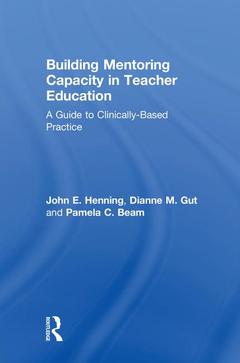Building Mentoring Capacity in Teacher Education A Guide to Clinically-Based Practice
Auteurs : Henning John E., Gut Dianne M., Beam Pamela C.

This book is an instructional guide for designing and implementing mentoring programs that support clinically-based teacher education. Veteran teacher educators John E. Henning, Dianne M. Gut, and Pam C. Beam outline a developmental approach for supporting mentees as they grow in their careers from teacher candidates to early-career teachers and teacher leaders. Mentors will learn how professional development occurs and how to create the conditions to foster and accelerate it. In Part I, chapters outline key components of the mentoring process, including strategies for engaging, coaching, co-teaching, and encouraging reflection. Part II demonstrates how those strategies can support mentees at different stages of their development. Included throughout are case studies, activities, and discussion questions to facilitate learning.
List of Tools List of Figures Preface Acknowledgements Definition of Terms Part I: Mentoring for Clinically-Based Teacher Education 1. Teacher Development 1.1 Introduction 1.2 The Role of Mentoring 1.3 Mentoring to Promote Teacher Development in Clinical Settings 1.4 Teacher Development in Context 1.5 Fostering Development in Context 1.6 The Development of Practice Towards Complexity 1.7 Fostering Development in Towards Complexity 1.8 The Development of Teacher Thinking 1.9 Fostering Development in Thinking 1.10 Organization of Chapters 1.11 Summary 1.12 Activity 2. Establishing the Mentoring Relationship 2.1 Introduction 2.3 Selecting the Mentor 2.4 Matching the Mentor and Mentee 2.5 Interview 2.6 Orienting the Teacher Candidate 2.7 The Teacher Candidate Questionnaire 2.8 Mismatch 2.9 Summary 2.10 Activities 3. Engaging Teacher Candidates 3.1 Introduction 3.2 Teacher Development 3.3 High Leverage Teaching Practices 3.4 The Developmental Curriculum for Clinical Experiences 3.5 Benefits of the Developmental Curriculum for Clinical Experiences 3.6 The Interactions Matrix 3.7 High Leverage Teaching Tasks 3.8 Summary 3.9 Activities 4. Co-Teaching 4.1 Introduction 4.2 Co-Teaching Benefits 4.3 Teacher Candidate Development through Co-Teaching 4.4 A Case Study of Co-teaching 4.5 Conceptual Framework for Co-Teaching 4.6 Summary 4.7 Activities 5. Coaching 5.1 Introduction 5.2 Teacher Development 5.3 Coaching Opportunities 5.4 Beyond Questions 5.5 The Language of Coaching 5.6 Coaching Dispositions 5.7 Modeling: Mentors Talk about Their Teaching 5.8 Summary 5.9 Activities 6. Reflection 6.1 Introduction 6.2 Teacher Development 6.3 Two Types of Reflection: Reflection-in-Action and Reflection-on-Action 6.4 Facilitating Reflection through Systematic Thinking: The DIJS Model 6.5 Fostering Critical Reflection 6.6 Summary 6.7Activities Part II: Building a Mentoring Culture 7. Initial Phase of Clinical Experience 7.1 Introduction 7.2 Teacher Development 7.3 Engagement 7.4 Co-Teaching 7.5 Coaching 7.6 Reflection 7.7 Summary 7.8 Activities 8. Intermediate Phase of Clinical Experience 8.1 Introduction 8.2 Teacher Development 8.3 Engagement 8.4 Co-Teaching 8.5 Coaching 8.6 Reflection 8.7 Summary 8.8 Activities 9. Continuous Phase of Clinical Experience 9.1 Introduction 9.2 Teacher Development 9.3 Engagement 9.4 Co-Teaching 9.5 Coaching 9.6 Reflection 9.7 Summary 9.8 Activities 10. Early Career Teachers 10.1 Introduction 10.2 Teacher Development 10.3 Engagement 10.4 Co-Teaching 10.5 Coaching 10.6 Reflection 10.7 Summary 10.8 Activities 11. Teacher Leaders 11.1 Introduction 11.2 Teacher Development 11.3 Engagement 11.4 Co-Teaching 11.5 Coaching 11.6 Reflection 11.7 Summary 11.8 Activities 12. Building a Mentoring Culture 12.1 Introduction 12.2 Challenges 12.3 Develop Your Vision 12.4 Building a Mentoring Culture 12.5 Summary 12.6 Activities ReferencesAppendix: High Leverage Teaching Tasks Index
John E. Henning is Professor and Dean of the School of Education at Monmouth University
Dianne M. Gut is Professor of Teacher Education at Ohio University
Pam C. Beam is Lecturer of Teacher Education at Ohio University
Date de parution : 08-2018
15.2x22.9 cm
Disponible chez l'éditeur (délai d'approvisionnement : 14 jours).
Prix indicatif 184,47 €
Ajouter au panierDate de parution : 08-2018
15.2x22.9 cm
Disponible chez l'éditeur (délai d'approvisionnement : 14 jours).
Prix indicatif 48,88 €
Ajouter au panierThèmes de Building Mentoring Capacity in Teacher Education :
Mots-clés :
Teacher Candidates; John E; Henning; Mentor Teachers; Dianne Gut; Engaging Teacher Candidates; Pamela Beam; Mentoring Teacher Candidates; clinically based teacher education; Teacher Candidate Development; teacher mentors; Professional Development; teacher preparation; Co-teaching Strategies; teacher-leaders; Early Career Teachers; teacher development; High Leverage Teaching Practices; Early Clinical Experience; teaching strategies; Student Engagement; reflective practice; InTASC Standard; learning through practice; mentoring tools; Encourage Teacher Candidates; assessment strategies; Recursive Learning; Dianne M; Gut; High Leverage Teaching; Pamela C; Beam; Teacher Leaders; Teacher Preparation Program; Teacher Candidate Assists; Challenge Teacher Candidates; Parallel Teaching; Action Research Cycle; Clinical Interns; Enable Teacher Candidates; Promote Teacher Candidates



